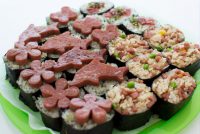Spam- Maui’s Most Unusual Local Food

In an environment of cuisine dominated by fresh seafood and locally harvested fruits and vegetables, there is one dietary oddball- Spam. Hawaii consumes 7 million cans of the chopped-up ham and byproducts loaf each year, even though there are only 1.42 million residents. So how has Spam maintained its place in Hawaiian cuisine? Related- See our Dining Guide for best recommendations from casual fare and happy hours to fine dining.
History of Spam in Hawaii
The story of how Spam became a vital part of Hawaiian culture is a colorful one involving World War II, rationing, and resilient Hawaiians who knew how to stretch this available source of protein, especially when feeding a hungry family. Hawaii was a war zone during World War II. There were government-mandated blackouts, food rationing, and food restrictions. Residents felt these restrictions even more because regular food supplies from the mainland were scarce. There was this constant fear of shipments of food suddenly not making it to Hawaii anymore, so a lot of people during that time had a tendency to hoard things like Spam and toilet paper. Spam came to represent precious nourishment in a time of uncertainty and chaos. Cooking with Spam
Cooking with Spam
The use of Spam would mark the beginning of a new Hawaiian food era. It was cut up, sautéed in shoyu (soy sauce) and sugar, and incorporated into a variety of dishes. Spam remains extremely popular in Hawaii today, in part because of its sentimental war-time roots.
For healthy eating, you would be better off visiting one of Maui's outstanding farmers markets. Spam is a processed food and is not really a great addition to any diet. But if you already like it, then you must try Spam musubi while you are on Maui for a local taste of the islands. It pairs fried Spam with sweet sticky rice, wrapped in seaweed, also called nori, and is so ono (delicious).
February 26th, 2019 | Dining




